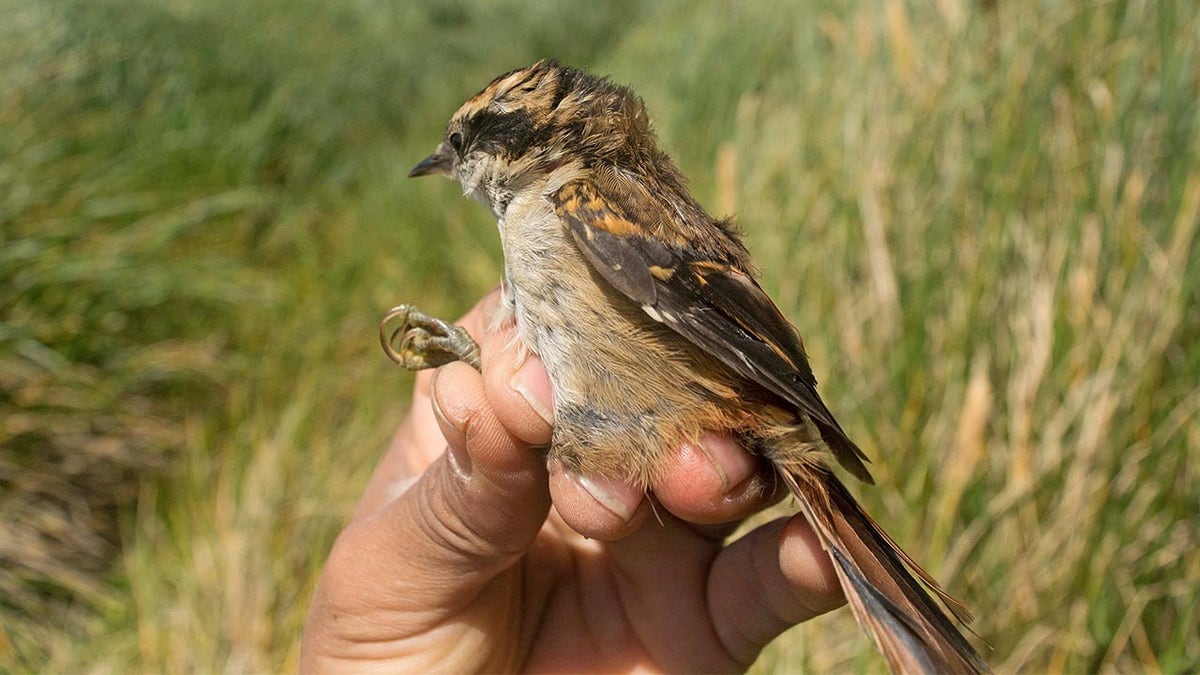'Fox & Friends Weekend' co-hosts face a new fear: Birds
Space Farms' Hunter Space and Mike McGuinness surprise the 'Fox & Friends Weekend' co-hosts with Angie the singing parrot and a rooster.
A new bird species — a small brown bird weighing about half an ounce — has black and yellow bands and a large beak, according to a report in Nature, the science journal, on Friday, August 26, 2022.
The new finding, scientists note, is proof of the importance of observing wild nature in some of the most remote places on Earth.
The Diego Ramirez Archipelago on the tip of South America is geographically isolated — plus it lacks terrestrial mammalian predators and woody plants, the study said.
QUIZ! NAME THAT BIRD! CAN YOU MATCH THESE BEAUTIFUL BIRDS WITH THEIR CORRECT NAMES?
"These birds move at shorter distances from ground level, and instead of nesting in cavities in trees, they breed in cavities in the ground, reflecting different life histories," the Nature study said.
The new bird was found in a treeless location, according to Reuters.

A newly identified bird, named rayadito subantartico (aphrastura subantarctica), is seen at Gonzalo island, Cabo de Hornos area, Magallanes region, Chile, in this undated handout picture released on August 26, 2022. (Universidad de Magallanes-Centro Internacional Cabo de Hornos/Handout via REUTERS)
One of the researchers, Rodrigo Vasquez, a biologist at the University of Chile, said that genetic studies confirmed that the newly discovered species "differs in a mutation from the rest of the species of the classic rayadito species," in addition to other differences in form and behavior, Reuters noted.
The newly identified bird has been named rayadito subantartico (aphrastura subantarctica).
The small group of subantarctic islands have a tundra climate — so tree growth there is impaired by bitter temperatures and short growing seasons.
"There are no bushes and no woodland species — literally in the middle of the ocean a forest bird has managed to survive," Ricardo Rozzi, an academic from Chile's University of Magallanes and the University of North Texas — as well as director of the Cape Horn International Center for Global Change Studies and Biocultural Conservation (CHIC) — told Reuters.
Rozzi also indicated that the species may turn into "a symbol … that will contribute" to information about the obscure Diego Ramirez Islands.
OSPREY FAMILY OF BIRDS GRAB UNEXPECTED ATTENTION AT WORLD CHAMPIONSHIPS IN EUGENE, OREGON
The research spanned six years.
During that period, scientists say they captured and measured 13 individual birds on the island.
"The birds from the Diego Ramirez population were significantly heavier and larger (with a longer and wider bill and longer tarsi), but they had a significantly shorter tail," the study said.
With the finding, researchers said the study emphasized "the need to monitor and conserve this still-pristine archipelago devoid of exotic species" brought in from elsewhere, usually by humans — which then often prey on local fauna, Reuters reported.
The study emphasized "the need to monitor and conserve this still-pristine archipelago devoid of exotic species."
The government of Chile in 2017 announced the creation of the Diego Ramírez Islands-Drake Passage Marine Park, to protect the Diego Ramirez Islands, according to reports.
The park includes 140,000 square kilometers of Chile’s southern waters, starting in the Cape Horn and extending south to the 200 miles of Chile’s economic zone toward Antarctica, Reuters noted.
As Nature reported, "The Diego Ramírez is the southernmost point of the South American continent. While emerging only ca. 100 km [62 miles] southwest of Cape Horn on the margin of the continental shelf, it is separated from it by one of the world’s roughest seas in the northern section of the Drake Passage, with harsh climatic conditions and difficult access from the continent."
CLICK HERE TO SIGN UP FOR OUR LIFESTYLE NEWSLETTER
The archipelago of small islets, rocks and reefs, it went on, "provides a total land area of only 79 hectares."
"The strong barrier to dispersal and the small size likely severely limit effective population migration to Diego Ramírez, thereby promoting the emergence of a fauna with zoogeographic novelties."
CLICK HERE TO GET THE FOX NEWS APP
The researchers said the bird's characteristics indicate that it's not a great flier — since in the area of the Diego Ramirez Islands wind gusts exceed 100 kilometers per hour (or about 62 miles per hour).
Reuters contributed reporting to this article.


